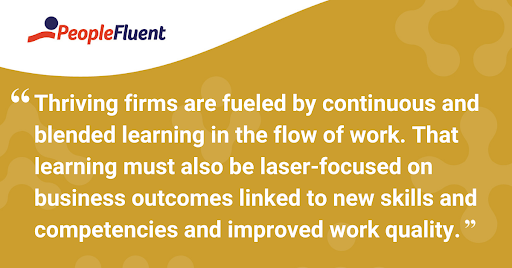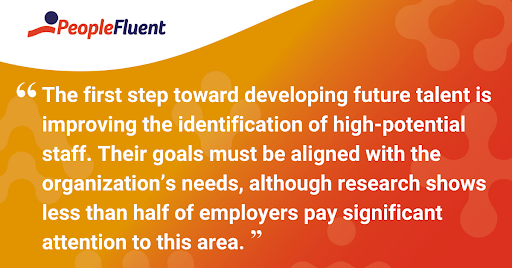Published: Nov 18, 2020Time to read: 6mins Category: Insights
5 Strategies to Improve Talent Mobility
There’s a lot of talk at the moment among HR teams about career mobility, especially in light of increasing pressure to upskill and reskill the workforce. In this article, Claude Werder, Senior Vice President and Principal HCM Analyst at Brandon Hall Group, looks at the importance of a talent mobility strategy and suggests five ways to enhance career pathing.
As the world of work responds to ongoing disruptions—from COVID-19, to social and political upheaval, digitalization, and a struggling economy—employers are under pressure to develop agile employees to help their organizations succeed.
But most employers don’t have a rich and deep talent pipeline to meet current business needs, or navigate an uncertain future. Employers must build a cohesive, effective approach to talent mobility.
Brandon Hall Group, having conducted quantitative research on talent mobility, with scores of interviews with Fortune 1000 companies, has developed five strategies for success.
More from the blog: ‘What Is Talent Mobility? Plus, What It’s Not!’
1) Build a Culture of Continuous Learning
Employee value is now defined by our teams’ ability to learn new skills and competencies. This agility enables adaptation to new situations that changes how work gets done.
But most organizations still take an event-based approach to learning, viewing training as something apart from work. In recent Brandon Hall Group leadership development research, 67% of responding organizations said their leaders and emerging leaders lack the time to learn.
That is a debilitating mindset in a volatile work environment.
Thriving firms are fueled by continuous and blended learning in the flow of work. That learning must also be laser-focused on business outcomes linked to new skills and competencies and improved work quality.

Related reading: ‘5 Ways a Creator-Centric Approach Prepares L&D for a Changing Role’
2) Drive Individual Growth Through Varied Experiences
More development must be experiential as the new world of work continuously evolves.
Learning should be applied to specific situations to maximize value. Everyone’s learning journey must include a wide variety of experiences with diverse people. Experiences that drive individual and collective growth include:
- Cross-functional team projects
- Job rotations
- Stretch assignments
- Certifications based on application of a combination of formal, informal, and experiential learning

3) Align Career Development and Succession Planning With Employee Potential
Most organizations assess employee potential for advancement with past or current performance. But performance has little to do with employees’ future value if they lack the motivation and agility to learn, change, and grow.
The first step toward developing future talent is improving the identification of high-potential staff. Their goals must be aligned with the organization’s needs, although our research shows less than half of employers pay significant attention to this area.
Rather than view potential through the lens of performance evaluations, as is done in most organizations, examine it through these three lenses:
- Engagement: Willingness of employees to consistently give their best and commit to the organization’s values and objectives, including learning and adapting to change.
- Capabilities: Employees demonstrable capabilities that can be applied to new roles in a changing business environment.
- Aspirations: An employee’s personal and professional dreams and goals, and what a successful career and personal life look like to them. This includes short- and long-term ambitions.
The secret to a larger, deeper talent pool is a holistic view of potential. From there, you can invest in learning and development with more perspective and greater confidence that the candidate’s goals are in alignment with the needs of your organization.
Related reading: ‘Rise of the Modern Talent Journey: Mapping the New Employee Experience’
4) Continually Assess to Understand Capabilities and Potential
Understanding and developing potential requires ongoing feedback and assessment rather than the traditional once- or twice-a-year performance evaluation.
Leaders and managers must play a lead role. Flexible goal-setting, coaching, mentoring, frequent check-ins, continuous feedback, and ongoing career conversations with employees are required, yet only 38% of organizations say they pay significant attention to them.
Formal assessments are helpful, especially to establish a base of skills, capabilities, and behaviors.
But receiving continuous assessment and feedback enables employees to improve their performance. Employee behavior change after the assessment and feedback is even more important. Their ability to absorb information and apply it provides insights into their ability to adapt to new situations and responsibilities.
5) Develop a Team Mindset
Seven out of 10 organizations say more than half of their work is accomplished through teams. According to our research, 62% of organizations say work accomplished through teams will increase significantly over the next one to two years. Therefore, it’s critical your high-potential employees have a team mindset and can work effectively in teams.
A team mindset is a commitment to leveraging diverse and complementary skills and competencies of individuals for the organization’s greater good. Capabilities and potential of individuals multiply in a team environment when members trust each other, respect each other’s strengths and limitations, and are motivated to work together effectively.
These behaviors do not come naturally to most people, so investment in team development is required to drive a true team mindset. But less than half of organizations say they have any kind of team development program and only 30% report their team development program is effective.
Since teams account for most work, it’s important to gain insight into the collaborative and team-building skills of individuals. How individuals work in teams should be a major factor in their mobility potential.

Hiring and Developing Internal, Not External Talent
A good talent mobility strategy is more than just pointing existing employees at job boards and seeing who applies. It’s about using technology to synch up people with mentors, projects, and opportunities to learn so that top performers are incentivized to stay in the business without stagnating.
Now more than ever, it’s time to prioritize promoting employee opportunities to grow in and with the organization. Because, to tweak the famous line from the 1989 movie Field of Dreams, ‘if you build them, they will stay’.
Ready to Start Opening Doors for Your Employees?
Get started today by providing your employees with a personalized approach to career development.